


MARTIN LUTHER 1483 - 1546 (R3, H7, H8)
xxxxxThe German priest Martin Luther was 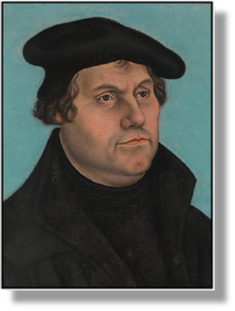 the instigator of the Protestant Reformation in northern Europe and, as such, is a major figure in the history of Christianity and western civilisation. He was born in Eisleben, Saxony, and studied at Erfurt University before becoming an Augustinian monk in the town. After being ordained a priest in 1507, he gained a reputation as a preacher at the new university at Wittenberg, and it was while there that, being critical of the Roman Catholic Church and anxious to bring about reform, he launched an attack upon the sale of indulgences. This was a practice whereby people were allowed to pay money to the church authorities - often the pope - in order to have their sins forgiven. Apart from the fact that the theological justification for such a procedure was questionable, it was clearly a system which was open to much abuse.
the instigator of the Protestant Reformation in northern Europe and, as such, is a major figure in the history of Christianity and western civilisation. He was born in Eisleben, Saxony, and studied at Erfurt University before becoming an Augustinian monk in the town. After being ordained a priest in 1507, he gained a reputation as a preacher at the new university at Wittenberg, and it was while there that, being critical of the Roman Catholic Church and anxious to bring about reform, he launched an attack upon the sale of indulgences. This was a practice whereby people were allowed to pay money to the church authorities - often the pope - in order to have their sins forgiven. Apart from the fact that the theological justification for such a procedure was questionable, it was clearly a system which was open to much abuse.
xxxxxHis attack came in 1517. 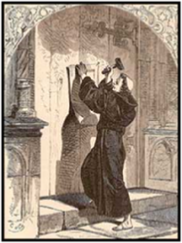 After openly denouncing the selling of indulgences - at this time being used to rebuild St. Peter’s Church in Rome - he posted his objections (95 theses) on the door of the castle church at Wittenberg, a recognised way of making one’s views known. Swiftly translated into German, and distributed widely throughout Europe, these objections evoked a storm of controversy which spread out in ever-widening circles. For a limited time, Luther had the backing of the Dutch theologian Erasmus, but as the protest movement took root he lost his support and, in addition, found himself attacked by a number of political and religious opponents. So alarmed was the pope at the turn of events that the Roman Curia condemned his teaching and, having excommunicated him, summoned him to appear at the Diet of Worms (an ecclesiastic council) in April 1521. He dutifully attended, but bravely refused to recant his views and took his criticism of Rome a deal further. The essence of Christianity, he argued, was a person’s direct communion with God; it was not dependent upon an elaborate organisation headed by a pope.
After openly denouncing the selling of indulgences - at this time being used to rebuild St. Peter’s Church in Rome - he posted his objections (95 theses) on the door of the castle church at Wittenberg, a recognised way of making one’s views known. Swiftly translated into German, and distributed widely throughout Europe, these objections evoked a storm of controversy which spread out in ever-widening circles. For a limited time, Luther had the backing of the Dutch theologian Erasmus, but as the protest movement took root he lost his support and, in addition, found himself attacked by a number of political and religious opponents. So alarmed was the pope at the turn of events that the Roman Curia condemned his teaching and, having excommunicated him, summoned him to appear at the Diet of Worms (an ecclesiastic council) in April 1521. He dutifully attended, but bravely refused to recant his views and took his criticism of Rome a deal further. The essence of Christianity, he argued, was a person’s direct communion with God; it was not dependent upon an elaborate organisation headed by a pope.
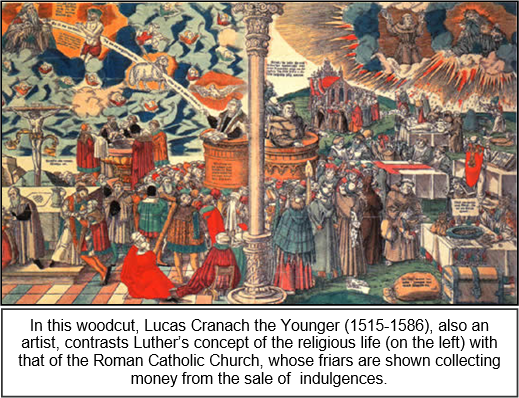 xxxxxSo what had been originally intended as a strong plea for reform by one man, led to an all-out breakaway movement from the Roman Catholic Church. Once put in motion it quickly grew in strength throughout northern Europe, fuelled by years of discontent over the running of the Roman church and papal interference in the affairs of independent states. The Augsburg Confession, the statement of the new Protestant faith drawn up by the church reformer Philip Melanchthon, was presented to the Emperor Charles V at the Diet of Augsburg in 1530. It brought into existence the Protestant Church and its creed. Confined at first to what came to be known as the Lutheran church (or Lutheranism), it was soon to spawn other branches of the protestant movement, led by reformers such as Ulrich Zwingli and John Calvin. By the time of Luther’s death in 1546 large areas of Northern Europe, and particularly Germany, Sweden and Denmark, had left the Roman Catholic Church and founded their own.
xxxxxSo what had been originally intended as a strong plea for reform by one man, led to an all-out breakaway movement from the Roman Catholic Church. Once put in motion it quickly grew in strength throughout northern Europe, fuelled by years of discontent over the running of the Roman church and papal interference in the affairs of independent states. The Augsburg Confession, the statement of the new Protestant faith drawn up by the church reformer Philip Melanchthon, was presented to the Emperor Charles V at the Diet of Augsburg in 1530. It brought into existence the Protestant Church and its creed. Confined at first to what came to be known as the Lutheran church (or Lutheranism), it was soon to spawn other branches of the protestant movement, led by reformers such as Ulrich Zwingli and John Calvin. By the time of Luther’s death in 1546 large areas of Northern Europe, and particularly Germany, Sweden and Denmark, had left the Roman Catholic Church and founded their own.
xxxxxAs for Luther himself, the Diet of Worms having declared him an outlaw and a heretic, he was obliged to take refuge in Wartburg Castle for some months, “kidnapped” by Prince Frederick III of Saxony for his own safety. From then onwards he gave much of his time over to study and writing, though he did visit the comparative remoteness of Wittenberg, and he did manage to do some travelling. At this time his main concern was not so much the opposition of the Catholics as the threat imposed by groups of fanatical protestants bent on violence.
xxxxxTo this period belongs his Small and Large Catechisms. He also left books containing his sermons, and a vast number of religious tracts, treatises and commentaries, not to mention thousands of letters and more than a dozen hymns. Three books written in 1520 contain his major views: Address to the Christian nobility of the German Nation, encouraging German princes to reform their own churches, the Babylonian Captivity, in which he attacks papal authority and some of the sacraments, and On Christian Liberty, wherein he stresses the importance of a personal faith. He also translated the bible into German, though he did receive help from a number of colleagues.
xxxxxIncidentally, Henry VIII, at this time a firm supporter of papal authority, condemned the teachings of Luther. His works were burned at Paul’s Cross, London, and the king wrote his The Assertion of the Seven Sacraments attacking the German priest’s heretical views. It was on the strength of this indictment that Pope Leo conferred on the king the title “Defender of the Faith”, a distinction which, despite Henry’s later break with the papacy, still appears on the coins of the realm!
xxxxxFor many years the German priest and well-known preacher Martin Luther had opposed the selling of indulgences, a practice much open to abuse whereby the Church took money for the forgiveness of sins. In 1517 he publicly nailed his objections to the door of Wittenberg Castle and evoked a storm of protest. The Roman Catholic Church condemned him at the Diet of Worms in 1521, but he refused to recant and went on to question the need of a church and a pope. So-called “Lutheranism” quickly spread and a statement of its faith was drawn up by the reformer Philip Melanchthon and presented to the Diet of Augsburg in 1530. At the same time other protestant movements developed, led by men like Zwingli and Calvin. In the meantime Luther had to take refuge in Wartburg Castle for some months. From then on he spent his time studying and writing. When he died in 1546 many parts of northern Europe had formed their own churches, independent of Rome. Luther's basic views - attacking papal authority and stressing personal faith - were contained in his three major works, Address to the Christian nobility of the German Nation, the Babylonian Captivity, and On Christian Liberty.
Including:
Philipp Melanchthon,
Ulrich Zwingli,
Lucas Cranach,
and Hans Sachs

xxxxxThe German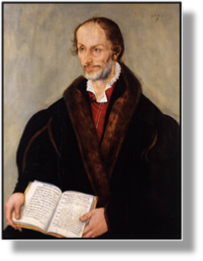 theologian Philipp Melanchthon (1497-1560) came under the influence of Luther when he was professor of Greek at Wittenberg and, as a consequence, began a study of theology, gaining a degree in 1519. It was he who, following the denunciation of Luther, assumed the leadership of the reformation. Having helped earlier to draw up the 21 articles of the Protestant faith, he presented them to the Emperor Charles V at the Diet of Augsburg in 1530. He also assisted Luther in the preparation of a German translation of the New Testament, and produced a number of bible commentaries and theological works, including his Apologia and his Variations. It is hardly surprising that he has been called “the scribe of the Reformation”.
theologian Philipp Melanchthon (1497-1560) came under the influence of Luther when he was professor of Greek at Wittenberg and, as a consequence, began a study of theology, gaining a degree in 1519. It was he who, following the denunciation of Luther, assumed the leadership of the reformation. Having helped earlier to draw up the 21 articles of the Protestant faith, he presented them to the Emperor Charles V at the Diet of Augsburg in 1530. He also assisted Luther in the preparation of a German translation of the New Testament, and produced a number of bible commentaries and theological works, including his Apologia and his Variations. It is hardly surprising that he has been called “the scribe of the Reformation”.
xxxxxA humanist scholar, Melanchthon took his name, meaning black earth, from the Greek translation of his family name. He was a close friend of Luther and an ardent supporter of his cause. His work Commonplaces of Theology, written in 1521, contained strong arguments in favour of the reformation, whilst his Passion of Christ and Antichrist of the same year - supported by woodcuts by Cranach - was a blistering attack upon the pope’s lifestyle as compared with that of Christ. However, he was always anxious to be a peacemaker between the two faiths and to avoid an all-out civil war, as occurred in Switzerland. This willingness to compromise on some aspects of dogma brought him into conflict with the staunch Lutherans of his day.
xxxxxHe was particularly keen on educational reform and, indeed, it was his Discourse on Reforming the Studies of Youth, the subject of his inaugural address at Wittenberg in 1518, that brought him to the notice of Luther. During his career he virtually reorganised the whole of the German educational system. He also helped in the reform of a number of universities and the founding of three new ones. He died in 1560 and was buried alongside Luther, his friend and fellow reformer.
xxxxxThe German theologian Philipp Melanchthon (1497-1560) was an ardent supporter of Lutheranism and took control of the movement after Luther was denounced. It was he who presented the 21 articles of the Protestant faith to the Emperor Charles V at the Diet of Augsburg in 1530. His Commonplaces of Theology and his Passion of Christ and Antichrist, both written in 1521, made the case for reformation and launched a blistering attack upon the pope's personal lifestyle. He was also keen on educational reform, putting into practice ideas from his Discourse on Reforming the Studies of Youth.
xxxxxIn 1523 the Swiss reformer Ulrich Zwingli (1484-1531), leader of his country's reform movement, persuaded Zurich to become a theocracy with himself in part control. Later, however, he broke with Luther over the nature of the sacrament of the body and blood of Christ, and they went their own ways. In 1529 he took up arms and won over six Cantons to the Reformation, but in trying to convert the remaining five, he was killed at the Battle of Kappel, and the protest movement made no further progress in Switzerland.
xxxxxThe Swiss reformer Ulrich Zwingli (1484-1531) 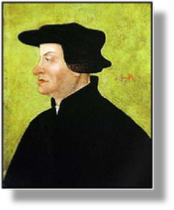 was ordained a Roman Catholic priest in 1506, but by 1519, having read the works of his contemporary Martin Luther, he had become the leader of the protestant movement in his homeland. For long critical of church abuses, such as the selling of indulgences and the promise of miraculous cures, he was summoned before the Zurich council in 1523. Here, insisting upon the supremacy of the scriptures over church dogma, and arguing that the devout Christian had no need of pope or church, his views won over the council members, and Zurich became a theocracy with Zwingli in part control.
was ordained a Roman Catholic priest in 1506, but by 1519, having read the works of his contemporary Martin Luther, he had become the leader of the protestant movement in his homeland. For long critical of church abuses, such as the selling of indulgences and the promise of miraculous cures, he was summoned before the Zurich council in 1523. Here, insisting upon the supremacy of the scriptures over church dogma, and arguing that the devout Christian had no need of pope or church, his views won over the council members, and Zurich became a theocracy with Zwingli in part control.
xxxxxIt was at this time, however, that differences of opinion began to emerge between Zwingli and Luther. The two protestant leaders met at Marburg in 1529 in the hope of reconciling their views over the precise nature of the sacrament of the body and blood of Christ, but no agreement was reached. Later that year Zwingli took up arms in the protestant cause and won over six cantons to the Reformation. The remaining five, however, known as the Forest Cantons, remained loyal to the catholic faith, and it was while taking the fight to them that he was killed at the Battle of Kappel. Following his death, the protestant cause made no further headway in Switzerland, and thus today the country remains divided, as then, between the two faiths.
xxxxxLucas Cranach the Elder (1472-1553) was a German painter and woodcut artist who became a firm friend and supporter of Luther, and virtually the official painter of the Protestant cause. His high regard for detail shows the influence of Durer, and he produced a vast output of religious works, portraits and allegories. His religious paintings included The Garden of Eden, and The Rest on the Flight into Egypt. One of his woodcuts shows Luther nailing his objections onto the door of Wittenberg Castle.
xxxxxThe portrait of 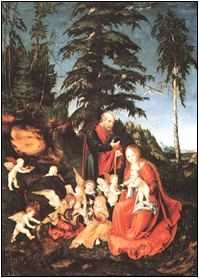 Luther above was the work of Lucas Cranach the Elder (1472-1553). He was a German painter and woodcut artist who became a close friend of Martin Luther and a firm supporter of his religious ideas. He painted his portrait a number of times as from 1520, and virtually became the official painter for the Protestant cause. In addition, he painted a number of altarpieces and paintings for Lutheran churches. He took his name from Kronach, the town of his birth, some fifty miles north of Nuremberg, but he spent 45 years of his life as court painter at Wittenberg, and was three times mayor of the town. Through his vast output of religious works, portraits and allegories he became a leading figure in the German Renaissance. He became known as the “swiftest of painters”, but his portraits show much attention to detail..
Luther above was the work of Lucas Cranach the Elder (1472-1553). He was a German painter and woodcut artist who became a close friend of Martin Luther and a firm supporter of his religious ideas. He painted his portrait a number of times as from 1520, and virtually became the official painter for the Protestant cause. In addition, he painted a number of altarpieces and paintings for Lutheran churches. He took his name from Kronach, the town of his birth, some fifty miles north of Nuremberg, but he spent 45 years of his life as court painter at Wittenberg, and was three times mayor of the town. Through his vast output of religious works, portraits and allegories he became a leading figure in the German Renaissance. He became known as the “swiftest of painters”, but his portraits show much attention to detail..
xxxxxHis hundred or so 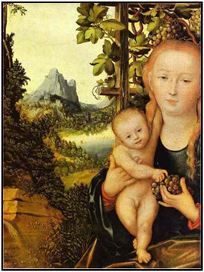 woodcut d
woodcut d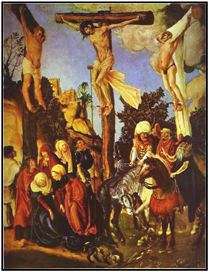 esigns, such as his St. Stephen, often show the influence of Durer, and some of his work is noted for its sensuous female nudes, as in The Judgement of Paris and his ten versions of Reclining Water Nymph. His religious paintings include the serene and beautiful Virgin and Child with a Cake, The Penance of St. Jerome, The Garden of Eden, and The Rest on the Flight into Egypt (illustrated above). Many of his works are remarkable for their composition and their wooded landscapes. Shown here are his Virgin and Child in a Grape Arbor, and his Crucifixion.
esigns, such as his St. Stephen, often show the influence of Durer, and some of his work is noted for its sensuous female nudes, as in The Judgement of Paris and his ten versions of Reclining Water Nymph. His religious paintings include the serene and beautiful Virgin and Child with a Cake, The Penance of St. Jerome, The Garden of Eden, and The Rest on the Flight into Egypt (illustrated above). Many of his works are remarkable for their composition and their wooded landscapes. Shown here are his Virgin and Child in a Grape Arbor, and his Crucifixion.
xxxxxThe German Hans Sachs (1494-1576) was a talented poet and composer. In about 1520 he became the master singer in his home town of Nuremberg and then the conductor of the group. He wrote over 4,000 master songs, including his Nightingale of Wittenberg (1523) in praise of Luther and all his work.
xxxxxThe German Hans Sachs (1494-1576) was a 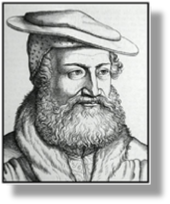 cobbler in Nuremberg who showed exceptional talent as a poet and composer. In about 1520 he won his place as a meistersinger (master singer) in his home town and, some years later, became the conductor of the group. During his long career he composed over four thousand master songs, many of which became very popular. Among those having a religious theme was the Nightingale of Wittenberg, an allegory in verse which praised Luther and all his work. Written in 1523, it did much to advance the Reformation in the Nuremberg area. Sachs, a man of humble origin, was later to feature prominently in the comedy-opera The Mastersingers of Nuremberg, produced by the German composer Richard Wagner and first performed in 1868.
cobbler in Nuremberg who showed exceptional talent as a poet and composer. In about 1520 he won his place as a meistersinger (master singer) in his home town and, some years later, became the conductor of the group. During his long career he composed over four thousand master songs, many of which became very popular. Among those having a religious theme was the Nightingale of Wittenberg, an allegory in verse which praised Luther and all his work. Written in 1523, it did much to advance the Reformation in the Nuremberg area. Sachs, a man of humble origin, was later to feature prominently in the comedy-opera The Mastersingers of Nuremberg, produced by the German composer Richard Wagner and first performed in 1868.



Acknowledgements
Luther: portrait by Cranach the Elder (c1472-1543) – Uffizi Gallery, Florence. Theses: date and artist unknown. Indulgences: by Cranach the Younger (1515-1586) – Kupferstichkabinett, Berlin. Melanchthon: portrait by Cranach the Younger (1515-1586), 1559 – Stadelsches Kunstinstitute, Frankfurt. Zwingli: portrait by the Swiss painter Hans Asper (1499-1571) – Museum of Art, Winterthur, Switzerland. Cranach the Elder: Flight into Egypt – Staatliche Museum, Berlin; Virgin and Child in a Grape Arbor – Pushkin Museum of Fine Arts, Moscow; Crucifixion – Kunsthistorisches Museum, Vienna. Sachs – portrait by the German artist Hugo Burkner (1818-1897), 1854.
H8-1509-1547-H8-1509-1547-H8-1509-1547-H8-1509-1547-H8-1509-1547-H8-1509-1547-H8



 the instigator of the Protestant Reformation in northern Europe and, as such, is a major figure in the history of Christianity and western civilisation. He was born in Eisleben, Saxony, and studied at Erfurt University before becoming an Augustinian monk in the town. After being ordained a priest in 1507, he gained a reputation as a preacher at the new university at Wittenberg, and it was while there that, being critical of the Roman Catholic Church and anxious to bring about reform, he launched an attack upon the sale of indulgences. This was a practice whereby people were allowed to pay money to the church authorities -
the instigator of the Protestant Reformation in northern Europe and, as such, is a major figure in the history of Christianity and western civilisation. He was born in Eisleben, Saxony, and studied at Erfurt University before becoming an Augustinian monk in the town. After being ordained a priest in 1507, he gained a reputation as a preacher at the new university at Wittenberg, and it was while there that, being critical of the Roman Catholic Church and anxious to bring about reform, he launched an attack upon the sale of indulgences. This was a practice whereby people were allowed to pay money to the church authorities - After openly denouncing the selling of indulgences -
After openly denouncing the selling of indulgences - xxxxxSo what had been originally intended as a strong plea for reform by one man, led to an all-
xxxxxSo what had been originally intended as a strong plea for reform by one man, led to an all-
 theologian Philipp Melanchthon (1497-
theologian Philipp Melanchthon (1497- was ordained a Roman Catholic priest in 1506, but by 1519, having read the works of his contemporary Martin Luther, he had become the leader of the protestant movement in his homeland. For long critical of church abuses, such as the selling of indulgences and the promise of miraculous cures, he was summoned before the Zurich council in 1523. Here, insisting upon the supremacy of the scriptures over church dogma, and arguing that the devout Christian had no need of pope or church, his views won over the council members, and Zurich became a theocracy with Zwingli in part control.
was ordained a Roman Catholic priest in 1506, but by 1519, having read the works of his contemporary Martin Luther, he had become the leader of the protestant movement in his homeland. For long critical of church abuses, such as the selling of indulgences and the promise of miraculous cures, he was summoned before the Zurich council in 1523. Here, insisting upon the supremacy of the scriptures over church dogma, and arguing that the devout Christian had no need of pope or church, his views won over the council members, and Zurich became a theocracy with Zwingli in part control. Luther above was the work of Lucas Cranach the Elder (1472-
Luther above was the work of Lucas Cranach the Elder (1472- woodcut d
woodcut d esigns, such as his St. Stephen, often show the influence of Durer, and some of his work is noted for its sensuous female nudes, as in The Judgement of Paris and his ten versions of Reclining Water Nymph. His religious paintings include the serene and beautiful Virgin and Child with a Cake, The Penance of St. Jerome, The Garden of Eden, and The Rest on the Flight into Egypt (illustrated above). Many of his works are remarkable for their composition and their wooded landscapes. Shown here are his Virgin and Child in a Grape Arbor, and his Crucifixion.
esigns, such as his St. Stephen, often show the influence of Durer, and some of his work is noted for its sensuous female nudes, as in The Judgement of Paris and his ten versions of Reclining Water Nymph. His religious paintings include the serene and beautiful Virgin and Child with a Cake, The Penance of St. Jerome, The Garden of Eden, and The Rest on the Flight into Egypt (illustrated above). Many of his works are remarkable for their composition and their wooded landscapes. Shown here are his Virgin and Child in a Grape Arbor, and his Crucifixion. cobbler in Nuremberg who showed exceptional talent as a poet and composer. In about 1520 he won his place as a meistersinger (master singer) in his home town and, some years later, became the conductor of the group. During his long career he composed over four thousand master songs, many of which became very popular. Among those having a religious theme was the Nightingale of Wittenberg, an
cobbler in Nuremberg who showed exceptional talent as a poet and composer. In about 1520 he won his place as a meistersinger (master singer) in his home town and, some years later, became the conductor of the group. During his long career he composed over four thousand master songs, many of which became very popular. Among those having a religious theme was the Nightingale of Wittenberg, an

